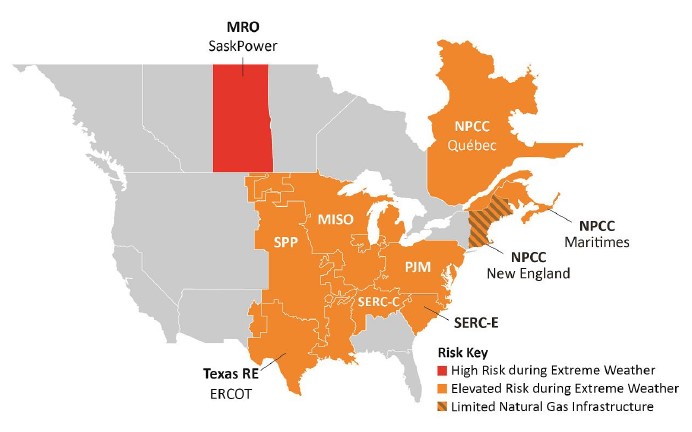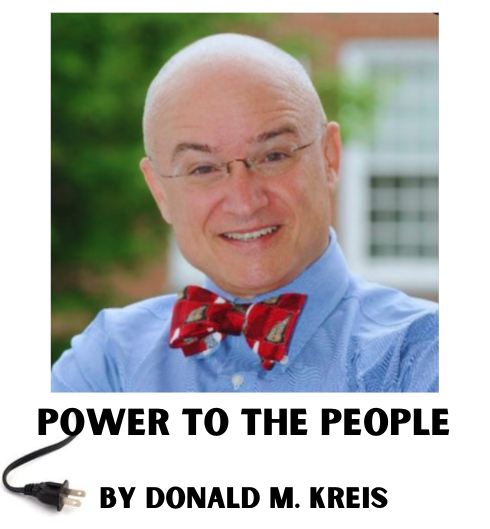
Above, New England stands out in the 2023 NERC reliability assessment map
Power to the People is a column by Donald M. Kreis, New Hampshire’s Consumer Advocate. Kreis and his staff of four represent the interests of residential utility customers before the NH Public Utilities Commission and elsewhere.
By DONALD M. KREIS, Power to the People
“Electric customers should get used to rolling blackouts every now and again,” said no ratepayer advocate — ever.
But if you are (as I am) New Hampshire’s ratepayer advocate, you might be tempted to make such a suggestion. Or, at least, to propose that showering generators, transmission utilities, pipeline companies, and the owners of liquified natural gas terminals with free money at the expense of electric ratepayers, all in the name of guaranteeing the grid will never go down, is a bad idea.
With the arrival of Standard Time comes the annual freak-out over the reliability of our electricity. This year, Exhibit A is the annual “winter reliability assessment” of the North American Electric Reliability Corporation (NERC), the non-government, utility-sponsored grid watchdog. Exhibit B is the report of the joint inquiry conducted by NERC and the Federal Energy Regulatory Commission (FERC) about the weather fiasco that hit New England last Christmas Eve after sweeping the continent west-to-east.
Journalists, conditioned to draw every negative inference they can from turgid documents like these, have taken the bait. A classic example is the November 15 account of Exhibits A and B from Robert Zullo of States News Service, as published by local affiliate New Hampshire Bulletin.
“Nearly a year ago, a Christmas weekend storm blasted across the country, forcing utilities to cut electricity to hundreds of thousands of people in parts of the southeastern U.S. after temperatures plunged, demand spiked, large numbers of power plants failed and natural gas supply was strained,” wrote Zullo.
Using the nickname that has somehow gotten attached to last December’s cold blast, Zullo continued: “As the anniversary approaches of Winter Storm Elliott, a pair of reports released last week reveal how much worse the situation almost became and the continued vulnerability of the U.S. energy grid to frigid weather.”
Zullo is based in Illinois. His story makes no mention of New England.
Let us, therefore, zoom in and take a look at what these FERC and NERC reports are saying about the likelihood of rolling blackouts (or worse) this winter in the six states whose bulk power transmission system and wholesale electricity markets are steered by the nonprofit grid operator ISO New England.
“ISO-NE expects to meet its regional resource adequacy requirements this 2023-2024 winter operating period for a mild or moderate winter,” states page 17 of the NERC Winter Reliability Assessment. “Load shedding is unlikely but may be needed under wide-area prolonged cold weather events.”
Check out the key words and phrases from NERC: “unlikely” and “may.” On page 45 of its report, NERC discloses that a “probability-based risk assessment” revealed that “[n]o cumulative . . . risks were indicated over the November-March winter period, for all the scenarios modeled.”
As for the NERC/FERC investigation, here’s what the jargon-rich report had to say about what went down in these parts in the late afternoon of Christmas Eve 11 months ago:
ISO-NE needed to invoke EEA 1 the evening of December 24. ISO-NE incurred over 2,000 MW of unplanned generation outages and derates in its footprint on December 24, and also experienced over 1,000 MW reduction of import power from Hydro Quebec due to the winter storm’s impact on Hydro Quebec’s system. Those conditions, coupled with high electricity demands, led ISO-NE to declare EEA 1 from 4:30 p.m. to 7:00 p.m., which was then cancelled as conditions improved in its BA.”
Don’t worry. I can translate that into English.
An “EEA 1” is simply a situation in which the grid operator – here, ISO New England – informs the neighboring regions that all of its available generation is in use and reserves have been exhausted. It is not ISO New England, or utilities, warning or even asking people to dial back their consumption.
“Derates” involve generators remaining on line but not producing at their full expected output. And Hydro Quebec, of course, is the provincial utility to our north that exports a lot of electricity to New England. “BA” stands for “balancing area,” which in this case just means New England except far northern Maine.
The bottom line: As bitterly cold, windy weather swept across the eastern half of the U.S. beginning on December 21, 2022, massive amounts of generation failed and ultimately there were more than 5,400 megawatts of rolling blackouts (or, in FERC/NERC parlance, “load shed”). The wholesale price of electricity in New England shot through the roof. But no load shedding occurred in New England or even in New York.
So where does that leave us, New Hampshire’s struggling ratepayers?
Well, regrettably, we cannot simply conclude that “it can’t happen here.” It can. The challenge is to make reasoned predictions about the future and spend money to prevent only those adverse events that are reasonably foreseeable.
ISO New England has said, many times over now, that it thinks it has the resources to get our region safely through the winter. Yes, there is a chance of rolling blackouts in the event of an extended cold snap that depletes the amount of fuel available to the natural gas generators on which our region is overly reliant.
ISO New England has also looked ahead to the winters of 2027 and 2032. Those analyses likewise suggest rolling blackouts are unlikely – even if the Everett Marine Terminal shuts down and can no longer supply fuel to gas-fired generators.
The Everett Marine Terminal, just north of Boston, receives shipments of liquified natural gas by boat from Trinidad and Tobago. By far Its biggest customer is Mystic Station, the region’s largest generator – scheduled for retirement next year.
Without Mystic Station, the Everett Marine Terminal is unlikely to stay in business – which poses a threat to natural gas utilities in Massachusetts, which also rely on the facility. But is that a reason to force New Hampshire electric customers to pay to keep this facility in business?
The answer to that question is “no.”
So, in that sense, the most disappointing example of an electric reliability freak-out is not from a journalist but from Willie Phillips, acting chairman of FERC. Along with NERC Chairman James Robb, Phillips put out a statement on November 6 saying he was “concerned about the potential loss of the Everett Marine Terminal.”
“To the extent that Everett . . . plays a role in supporting electric reliability by making needed energy supplies available, in the near-term or the future, [New England] should consider how to ensure that any needed reliability contributions are appropriately valued,” said the statement from Phillips and Robb.
That’s an unmistakable nudge from the nation’s top energy regulator in favor of extracting free money from New England electric customers to keep that thing open. It’s a great idea if you favor spending to infinity in quest of a guarantee that the electricity grid will never fail. Ratepayers need a more reasoned approach to this challenge.





